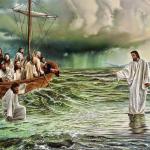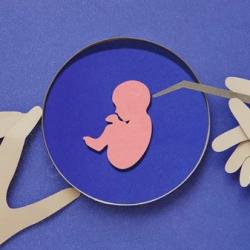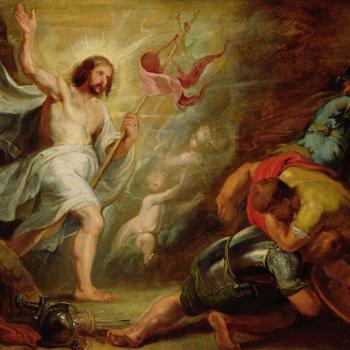Is resurrection the ultimate miracle?
ST 4146 Miracles 6
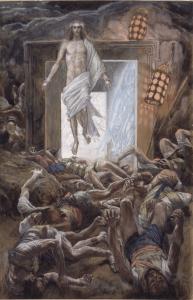
If history has a hinge which opens the past to the future, that hinge would be the day God raised Jesus from the dead. That hinge day is the first Easter. On the first Easter the new creation slammed the door on the old creation. But we must ask a technical question: is resurrection a miracle? Is resurrection the ultimate miracle?
There is more at stake than merely Jesus’ Easter resurrection in the past. Your and my resurrection in the future is also at stake. “But in fact Christ has been raised from the dead, the first fruits of those who have died” (1 Corinthians 15:20). To say it another way, Jesus’ Easter resurrection is a prolepsis of the future resurrection, the inauguration of God’s eschatological new creation (Peters, The Future of Resurrection 2006). Jesus’ historical resurrection prefigures cosmic eschatology.
Wandering in Hume’s Shadow
But this Christian promise seems so extravagant! So doubtful! So impossible! Right?
Everyone who dies remains dead. That’s the law. How do we know it’s a law? Well, did you ever see someone rise from the dead? No, you did not. Therefore, it’s a universal law of nature. It follows, then, that when we study a historical report of someone rising from the dead, it must be dismissed as unhistorical.
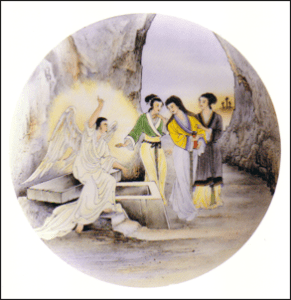
Did you follow that logic? It’s called the principle of analogy in historiography.
Recall in an earlier post how David Hume (1711-1776) relies on our common experience of nature’s uniformity to reject past reports of disruptions in nature’s uniformity.
“The objects, of which we have no experience, resembles those, of which we have; that what we have found to be most usual is always most probable; and that where there is an opposition of arguments, we ought to give the preference to such as are founded on the greatest number of past observations” (Hume 1748, Section X).
The shadow cast by Hume plunges historical research into darkness, making it difficult to see uniqueness in past events.
Analogy in Historiography and Theology
A century and a half after Hume, German historian and theologian Ernst Troeltsch (1865-1923) turned nature’s uniformity into the principle of analogy. The analogy principle says something like this: if an ancient report is not analogous to our recent experience with the uniformity of nature, then the event reported is unhistorical. In his methodological essay of 1898, “Historical and Dogmatic Method in Theology” (Ũber historische und dogmatische Methode in der Theologie), Troeltsch relies on a fundamental homogeneity (Gleichartigkeit) of all historical events. This means that the past does not differ essentially from the present.
“This omnipotence of analogy, however, presupposes the fundamental similarity of all historical occurrences. It does not presuppose an identity but a similarity that leaves all possible room for distinctions. But it depends on a kernel of common similarity from which distinctions can be sensed and grasped” (Troeltsch 1898, 1913).[1]
What is the impact of the principle of analogy on biblical miracle reports? What happens to the Gospel reports that Jesus rose from the dead on the first Easter? Because we do not see people rising from the dead in today’s experience, it follows that Jesus, most probably, did not rise from the dead.
Donghwi Kim fears that Troeltsch like Hume has surreptitiously snuck ideology into historical method (Peters 1998). This ideology is known as metaphysical naturalism.
“If miracles do not occur today, they did not occur in the past. Unfortunately, however, the principle of analogy in this way appears to assume ‘metaphysical naturalism’, since it presupposes a priori that miracles do not happen today, and vice versa” (Kim 2023, 345).
This means that reports of Jesus’ rising from the dead on the first Easter are so improbable that we can deem them unhistorical. If you are a metaphysical naturalist, that is. Resurrection accounts can be dismissed as either hallucinations or propaganda by the early church.
In sum, the shadow Hume and now Troeltsch obnubilates the theologian’s reliance on historiography to shore up the foundations of the Easter faith.
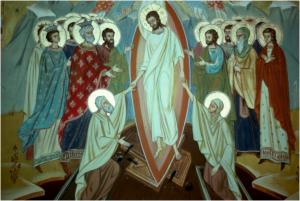
“No” to the Principle of Analogy
Robert John Russell, the coordinator of Donghwi Kim’s dissertation, label’s the principle of analogy, “nomological universality.”
This is problematic, says Russell. Nomological universality is unproven and unverifiable. It simply presupposes the closed causal nexus we find in Newton, Hume, and even Troeltsch. Nomological universality is not the result of scientific research. Rather, it is an assumption that turns science into an ideology.
This assumption means that if God were to act and transform the natural world, the principle of analogy or the principle of nomological universality would blind the historian from even seeing this divine act.
“Yes” to Resurrection as the Ultimate Miracle
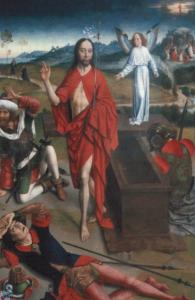
Russell proceeds then to describe God’s action in raising Jesus from the dead as the “First Instance of a New Law of the New Creation” (FINLONC) (Russell 2002). The laws that will govern God’s eschatological new creation will include, among other healing processes, the resurrection of the dead.
Or, to reverse it, the historical event of Jesus’ Easter resurrection represents the new creation breaking into the old. Jesus’ Easter resurrection, then, becomes a prolepsis or anticipation of what God has promised for the future.[2]
Russell says more. God has created the present world order in such a way that it is open to transformation. Our natural world already contains within it conditions and characteristics that opens it to the new, to redemption (Russell, Time in Eternity: Pannenberg, Physics, and Eschatology in Creative Mutual Interaction 2012).
According to Russell, then, Jesus’ Easter resurrection is more than a miracle. Much more. It’s the ultimate miracle.
Wright gets it right.
In his monumental book, The Resurrection of the Son of God, New Testament historian N.T. Wright emerges from the shadow cast by Human and Troeltsch. That Jesus in fact rose from the dead on the first Easter is the most probable explanation for the evidence we find in the early church testimony.
But Wright does not ask the historian to do the work of the theologian.
“Historical argument alone cannot force anyone to believer that Jesus was raised from the dead … the proposal that Jesus was bodily raised from the dead possesses unrivaled power to explain the historical data at the heart of early Christianity” (Wright 2003, 718).
The ultimate miracle is a prolepsis of the ultimate transformation.
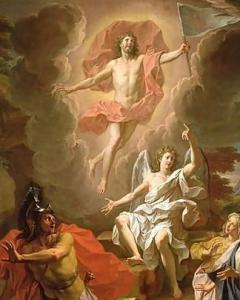
Resurrection in the NT comes in two degrees. The first degree includes the resurrection miracles Jesus performed on dead persons such as Jairus’ daugher (Mark 5), the widow’s son at Nain (1 Kings 17; Luke 7), and Lazarus (John 11). Each of these three stood up from their death rest and went back to their normal lifes. They would each have to die again at some point. Their post-resurrection lives would be temporary.
Jesus’ Easter resurrection differs. Jesus rose to eternal life. He would never die again. That’s the resurrection that prefigures your and my resurrection. This is why we dub the Easter resurrection the ultimate miracle.
The theological context for interpreting the resurrection miracles of Jairus’ daugher, the widow’s son at Nain, and Lazaarus along with the Easter resurrection of Jesus is eschatology. Rather than think with Hume that miracles break a law of nature, miracles actually break into nature with the laws of the new creation. This is a conclusion I share with both Russell and Kim.
“Miracles are, in some ways, signs of a better eschatological kingdom for all who put their hope in Jesus Christ. Such signs reveal a kingdom now veiled by the cross, which is also associated with suffering, but as signs of that kingdom’s power, miracles are portents of the hope that lies beyond the cross—the essential gateway to the resurrection” (Kim 2023, 430).
Conclusion
Although he has never personally seen a miracle, evangelical theologian Roger E. Olson says that each Christian must believe in at least one miracle. Which one? Jesus’ Easter resurrection from the dead. Jesus’ resurrection is miraculous, Olson says, because here “a truly dead person [is] coming back to life. By ‘truly dead’ I mean brain dead and with somatic, physical decomposition.” This is a rigorous criterion. But, for the resurrection to be proleptic exacts an even more rigorous criterion.
The resurrection of the dead Jesus on the first Easter is, according to Donghwi Kim, the ultimate miracle. It is ultimate because in this proleptic event the power of the new creation manifested itself with its transformative power. A new law of nature was inaugurated. Yes, the dead shall rise.
Where have we been? Where are we going?
Patheos ST 4141 How to see a miracle? Miracles 1
Patheos ST 4142 Two Healing Miracles for Sainthood. Miracles 2
Patheos ST 4143 Hume on Miracles. Miracles 3
Patheos ST 4144 Is Special Divine Action miraculous? Miracles 4
Patheos ST 4145 Jesus’ Nature Miracles. Miracles 5
Patheos ST 4146 Is resurrection the ultimate miracle? Miracles 6
Patheos ST 4147 The proleptic power of new creation. Miracles 7
Patheos ST 4148 Paul Lange on Miracles. Miracles 8
Patheos ST 4149 C.S. Lewis on Miracles. Miracles 9
▓
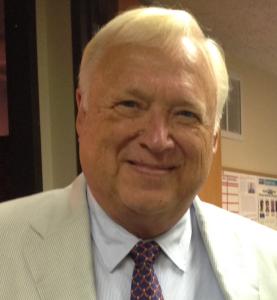
Ted Peters (Ph.D., University of Chicago) is a public theologian directing traffic at the intersection of science, religion, and ethics. Peters is an emeritus professor at the Graduate Theological Union, where he co-edits the journal, Theology and Science, on behalf of the Center for Theology and the Natural Sciences, in Berkeley, California, USA. He recently co-edited Astrobiology: Science, Ethics, and Public Policy (Scrivener 2021) as well as Astrotheology: Science and Theology Meet Extraterrestrial Intelligence (Cascade 2018). He also co-edited Religious Transhumanism and Its Critics (Lexington 2022) and The CRISPR Revolution in Science, Ethics, and Religion (Praeger 2023). Peters is author of Playing God: Genetic Determinism and Human Freedom (Routledge, 2nd ed, 2002) and The Stem Cell Debate (Fortress 2007). See his blogsite [https://www.patheos.com/blogs/publictheology/] and his website [TedsTimelyTake.com].
▓
Notes
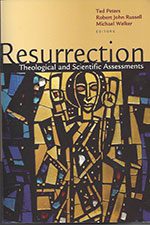
[2] Jesus’ Easter resurrection may look to us like a miracle, that is, if we think of a miracle as contradicting what is fixed by nature. Yet, there is another way to look at it: Jesus’ resurrection is not an exception to the fixed laws of nature. Rather, it is the first instantiation of a new law of nature. What happened to Jesus at Easter is not simply a miracle within a world that will continue to see resurrection as anomalous, as unique, as miraculous. “I usually refer to it as ‘more than a miracle’, writes Robert John Russell; “since his resurrection seems to involve the transformation of nature as a whole rather than an intervention into the processes of nature which leave them otherwise untouched” (Russell, Cosmology from Alpha to Omega: The Creative Mutual Interaction of Theology and Science 2008, 129).
Works Cited
Hume, David. 1748. Enquiry Concerning Human Understanding.
Kim, Donghwi. 2023. Miracles Reconsidered: A Fresh Assessment from Philosophy, Science, and Theology. Graduate Theological Union Ph.D. dissertation: unpublished.
Pannenberg, Wolfhart. 1970-1971. Basic Questions in Theology, 2 Volumes. Minneapolis: Fortress.
Peters, Ted. 2006. “The Future of Resurrection.” In The Resurrection: John Dominic Crossan and N.T. Wright in Dialogue, by ed Robert Steward, 149-170. Minneapolis: Fortress.
Peters, Ted. 1998. “The Use of Analogy in Historical Method.” Catholic Biblical Quarterly 37:1 475-482.
Russell, Robert John. 2002. “Bodily Resurrection, Eschatology, and Scientific Cosmology.” In Resurrection: Theological and Scientific Assessments, by Robert John Russell, and Michael Welker, eds Ted Peters, 3-30. Grand Rapids MI: Wm. B. Eerdmans.
—. 2008. Cosmology from Alpha to Omega: The Creative Mutual Interaction of Theology and Science. Minneapolis MN: Fortress Press ISBN 978-0-8006-6273-8.
—. 2012. Time in Eternity: Pannenberg, Physics, and Eschatology in Creative Mutual Interaction. Notre Dame IN: University of Notre Dame Press ISBN 13: 978-0-268-04059-8.
Troeltsch, Ernst. 1898, 1913. On the Historical and Dogmatic Methods in Theology. Gesammelte Schriften II, 728-753.
Wright, NT. 2003. The Resurrection of the Son of God. Minneapolis MN: Fortress.



